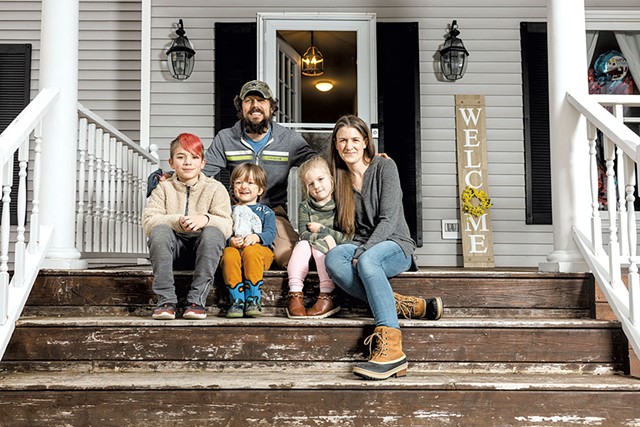
- Oliver Parini
- Ryan and Caroline Dahlstrom with their children, Robbie, Wilder and Shay
Earlier this month, when Vermont officials announced that masking guidance for K-12 schools would end on March 14, they cited new federal guidance and low COVID-19 hospitalization rates as reasons that the move made sense.
"I think it's time that we get back to some sort of normal, for kids in particular," Gov. Phil Scott said at his weekly press conference on March 3. "To see their classmates' faces again, their facial expressions, to socially interact and not be in a constant state of fear."
But for Caroline Dahlstrom, a mother of three in Williston, the announcement was an unwelcome jolt.
Dahlstrom's youngest child, 4-year-old Wilder, has myriad disabilities and has undergone several surgeries to help him breathe. He is dependent on supplemental oxygen, uses a feeding tube and has a "pretty much entirely nonfunctional" immune system, Dahlstrom said.
This school year, when COVID-19 cases cropped up in her daughter's kindergarten and her son's fourth-grade class, Dahlstrom kept them out of school — on the advice of Wilder's doctors — to ensure they didn't bring the virus home to their little brother. During the Omicron surge in the winter, the two older kids stayed home for six weeks straight.
When COVID-19 cases declined in February, the children went back to class and Wilder — who had not attended preschool in person since the pandemic started — was able to go to the Allen Brook School building one time to receive special-education services.
"I finally felt like I could take a deep breath for the first time in months," Dahlstrom said, "and then they dropped masks."
Since then, things have been rocky for Dahlstrom's family. Her kindergartner has struggled with keeping her mask on when others in her class aren't wearing one. And her older son had to stay home last week because several classmates tested positive for COVID-19.
Dahlstrom said she feels let down that state officials haven't put more thought into how COVID-19 policies affect families like hers.
And she's not alone. Health experts and others with immunocompromised or medically fragile family members say the removal of COVID-19 mitigation measures in schools — which also include a winding down of school-based testing — don't take into account the needs of high-risk Vermonters.
They also argue that the state's focus on personal responsibility in combating the virus is not sound public health policy.
"When we shift our responsibility from institutions or policies to individuals, what we're doing is, we're concentrating the risk and burden on the most vulnerable in our communities," Dartmouth College public health researcher Anne Sosin said in a presentation last week sponsored by the Education Justice Coalition of Vermont. "So, as we make this shift, what we're seeing is ... the environments that high-risk people are inhabiting are less safe."
Montpelier-based physician Melissa Houser, who works with kids and adults with disabilities, also sees flaws in the state's messaging.
Stressing the importance of personal responsibility, but then not offering high-risk families an alternative if they deem schools too risky, doesn't make sense, Houser said. "You're basically taking away families' autonomy over keeping their children safe," she said.
Houser described the state's stance as "ableist."
"When we knowingly or unknowingly put some people in our community at risk or in harm's way, we're sending the message that we don't care as much about those people," Houser said.
Some of Houser's clients are forced to choose whether to send their children to school or protect their health. People faced these hard decisions throughout the pandemic, "but now it's differentially impacting a group of people as compared to all the people," she said.
Northeast Kingdom resident Kate Larose, who has an immunocompromised 9-year-old, is one parent who is weighing her options. Because her family lives in Canaan, the only school district in Vermont that did not require students to mask this year, she got special permission for her child to attend a public school in another district. Larose and her husband drive four hours round-trip to get their child to and from school. Now that school has gone mask-optional, just like Canaan.
Larose said she is also worried about the policy change that allows COVID-19-infected students and staff to return to school after just five days and without having received a negative test. In deciding whether her child can continue going to school, she said she's planning to take it day by day.
Last week, Larose said, her child asked her, "Why are all my schools turning against me?'"
"That just hit me so hard," Larose said. "This is what it feels like for everyone who is high-risk right now — that the schools are turning against them, that their communities are turning against them."
Larose called in to Vermont Public Radio's "Vermont Edition" last week to explain her situation to Health Commissioner Mark Levine.
"I don't think we'll find a place in the United States where Kate's problem is not occurring," Levine said on the program, "so the challenge, of course, is to try to remain attentive to the needs of those who are most in need and still have the remainder of the population be able to move on in their lives in some way."
Levine recommended that parents in Larose's situation work with school staff and classmates' families to try to figure out how high-risk students can remain integrated in the school community.
"I would submit that during a very strong flu season, all of the same concerns might have arisen in other years for students like Kate's," Levine added, "and that we have to all rally together to try to ... negotiate those difficult times."
On Monday, Agency of Education spokesperson Ted Fisher said in an email that each school will need to figure out what works best. Many already have tools in place for students with special needs that they can use to support those at high-risk.
"This requires a shift from following general state guidance in favor of evaluating each case at the local level and deciding if specific accommodations are necessary," Fisher wrote.
The Department of Health echoed Levine's position, writing in a statement that "the ability to ensure a healthy learning environment also relies on individual and community commitment."
"COVID-19 will be with us for some time," spokesperson Ben Truman wrote in an email, so it's important for people to consider the needs of others. That means "respecting personal decisions regarding masks, [showing] empathy for those who make personal choices for whatever reason to wear a mask and understanding we all have a societal role to try to protect those who are most vulnerable."
Larose doesn't think it's the responsibility of the most affected individuals to rally their schools and communities to support them, though. Instead, she said, the state should have school and health policies that accommodate high-risk students.
Those might include a permanent virtual learning option, required outdoor spaces for eating lunch or classrooms designated for masked students, "just like we have peanut-free zones in the cafeteria," Larose said.
Erika Smith of East Montpelier also sees shortcomings in the state's response. Smith has two sons: 13-year-old Slade and 6-year-old Rowen, who has a complex array of medical needs due to a brain malformation. When the pandemic hit, Rowen was in his first year of preschool, but since March 2020, he's had to stay home.
Slade also attended school virtually last school year and this fall, when the family was staying in Boston while Rowen underwent surgeries. But Slade struggled with remote learning, Smith said, so in January, the family decided he would return to in-person instruction at U-32 Middle & High School.
Now, about two months later, the end of masking guidance creates another hurdle for her family.
"We were feeling like, Oh, my gosh, just as he got back and he's doing so well, now what's going to happen?" she said.
Smith said she's concerned that the state and school district are no longer providing accurate data about COVID-19 infections in schools, which would help her make informed decisions. As a precaution, Slade still tests at home for the virus at least three times a week and has told her he's fine with wearing a mask in school, even if others don't. Smith said she plans to let him continue attending school unless there's "a huge spike" in cases.
Students themselves are also taking action. Sixteen-year-old Izzy Shrout and a group of peers staged a walkout at Montpelier High School in early March to protest the lifting of masking guidance.
Shrout's mother is immunocompromised, a younger sister has asthma and a younger brother is too young to be vaccinated.
Shrout said being around large groups of unmasked people is anxiety-provoking. School administrators have tried to help, providing a private space to eat lunch and work online. Still, Shrout recalled being coughed on and sneered at in the hallway for wearing a mask. Last week, Shrout felt the need to abruptly leave a class because many peers were unmasked.
Shrout thinks that state officials should have consulted students before they ended masking in schools.
"I feel like [Gov. Scott] making these statements about what we need is kind of ridiculous, because he didn't ask what we needed," Shrout said.
Dahlstrom, the Williston mom, also wishes families with high-risk kids had been consulted before masking policies were changed. On the first mask-optional day of school, Dahlstrom got a call from her daughter's teacher because her daughter had taken her mask off midway through the school day. The teacher took her out into the hallway and persuaded her to put it back on, agreeing to be her "mask buddy" in solidarity for the rest of the school year.
That night, Dahlstrom said, she had a teary conversation with her daughter about why she needed to keep her mask on. Still, Dahlstrom's daughter has continued to tell her how alone she feels.
"She doesn't get it, why everybody else took off their masks if COVID is still around," Dahlstrom said. "And I try to explain it ... but I don't have a great explanation."
At a minimum, Dahlstrom said, she would like for COVID-19-positive students to be required to show a negative test before returning to school. She can't help but feel deflated by the behavior of fellow members of the school community.
"I have had feelings of [being] let down that everybody took off their masks on day one, when they know our family and they know our situation," Dahlstrom said. "I would be lying if I said I didn't feel hurt by that."
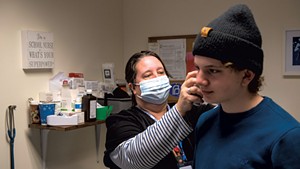
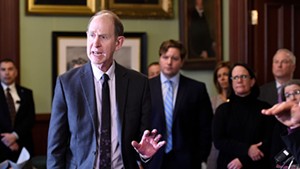
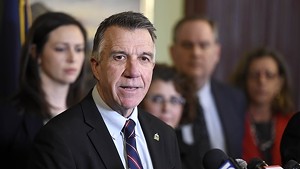
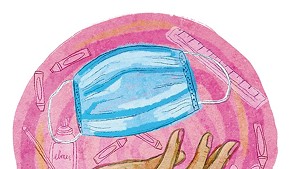
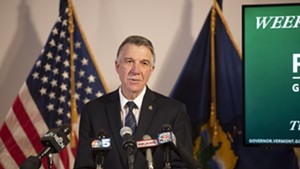









Comments
Comments are closed.
From 2014-2020, Seven Days allowed readers to comment on all stories posted on our website. While we've appreciated the suggestions and insights, right now Seven Days is prioritizing our core mission — producing high-quality, responsible local journalism — over moderating online debates between readers.
To criticize, correct or praise our reporting, please send us a letter to the editor or send us a tip. We’ll check it out and report the results.
Online comments may return when we have better tech tools for managing them. Thanks for reading.